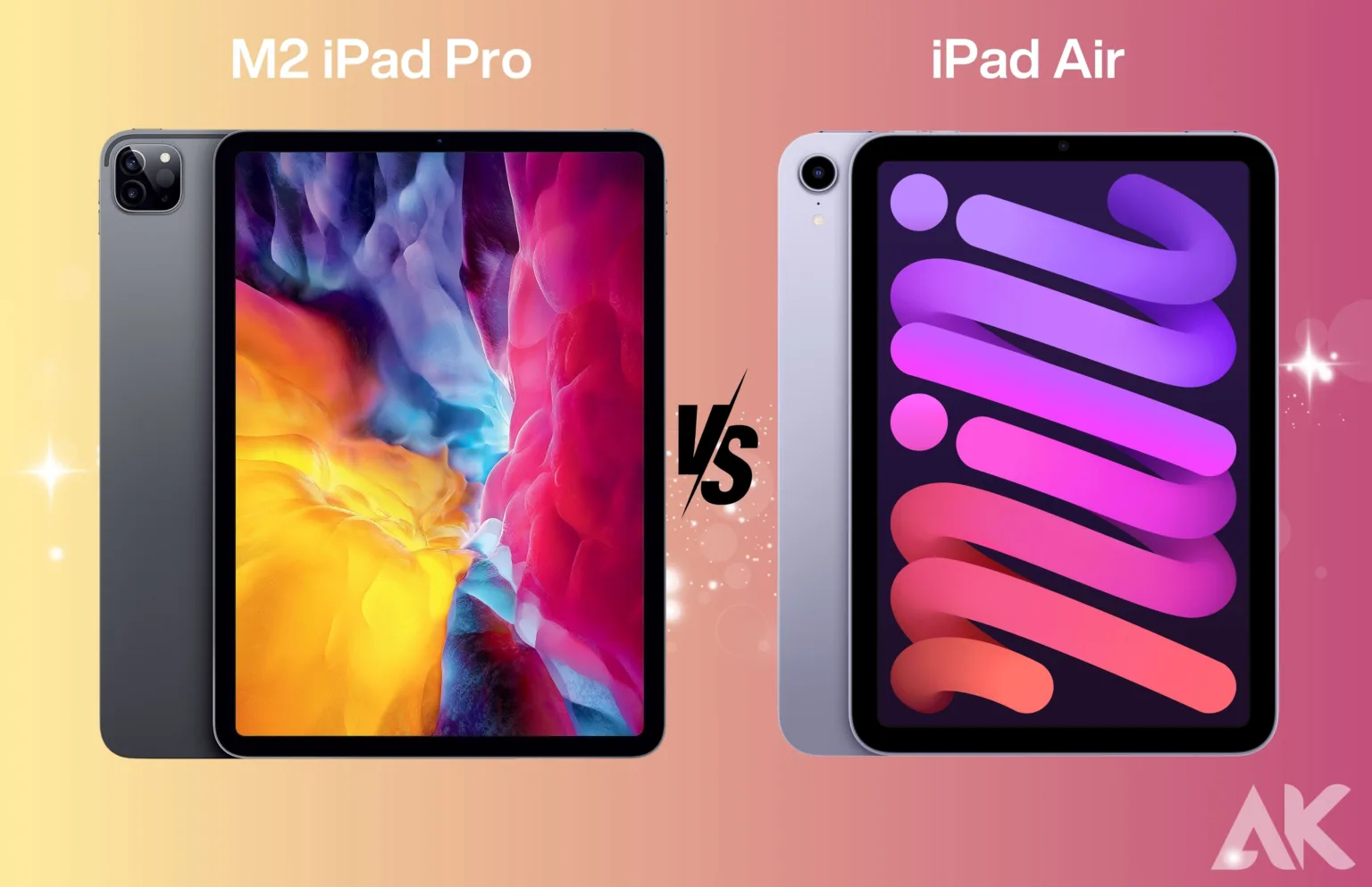M2 iPad Pro vs iPad Air Pros and Cons: Two models that prospective purchasers often compare when thinking about the newest models in Apple’s tablet portfolio are the iPad Air and the M2 iPad Pro. Choosing between them is about more than only money since each has its pros and cons. The state-of-the-art M2 processor in the iPad Pro allows for exceptional performance and features, making it an ideal tablet for power users and professionals who need a device that can effortlessly manage demanding tasks.
However, for those who need a high-quality tablet experience but don’t require the additional power and capabilities of the Pro model, the iPad Air might be a good choice due to its reduced weight and lower price. To help those who are having trouble deciding between these two great products, we will examine the advantages and disadvantages of the M2 iPad Pro and the iPad Air.
M2 iPad Pro vs iPad Air Design and Build Quality
When comparing the M2 iPad Pro with the iPad Air, it’s clear that Apple prioritized both form and function. The M2 iPad Pro’s slim and lightweight aluminum body is both a hallmark of high-end design and a reliable companion for everyday usage. The edge-to-edge display gives it a contemporary appearance and makes the most of the screen real estate, which improves the user experience even more. Meanwhile, the iPad Air sticks to the same design idea but stands out with a rainbow of color choices to suit everyone’s taste. Because of this variety, consumers may choose a gadget that not only works for them but also expresses who they are.
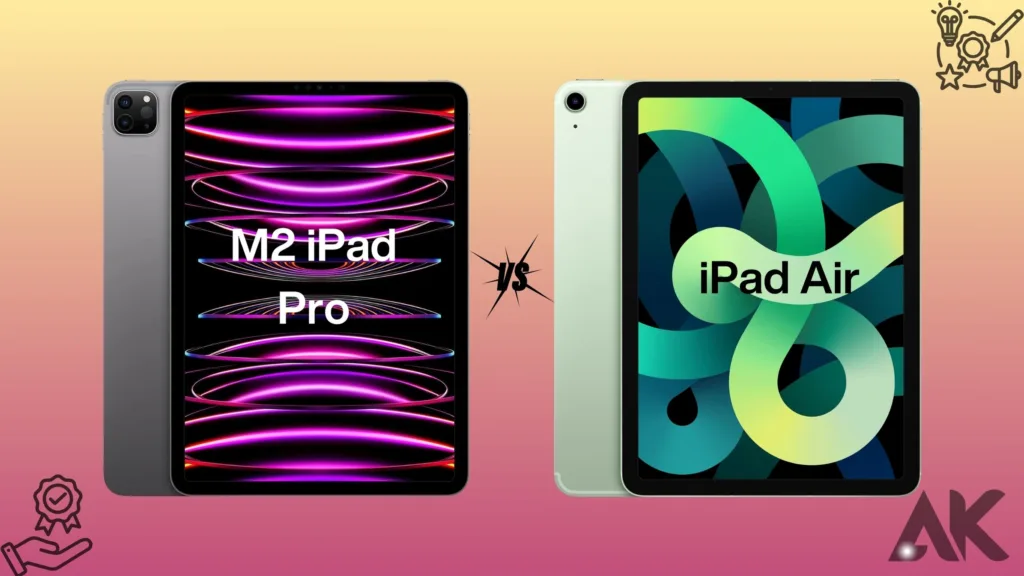
Despite these shared features, the M2 iPad Pro stands apart because of its ProMotion technology. This allows for an adaptable refresh rate of up to 120Hz, making the tablet more sensitive to touch input and allowing for smoother scrolling. This feature highlights the target audience of the Pro model, providing them with a better visual and interactive experience; it is mostly useful for professionals and creatives. Though its heavier build makes it less comfortable to use for extended periods, the iPad Air makes up for it with a lighter chassis, which may be more appealing to casual users or those who value mobility more than state-of-the-art functionality.
Both devices include an anti-reflective coating, a completely laminated display, and True Tone technology, which guarantees a pleasant viewing experience in all kinds of lighting settings and excellent build quality. In the end, it comes down to personal taste when it comes to size, weight, and screen technology when deciding between the M2 iPad Pro and iPad Air in terms of design and build quality.
M2 iPad Pro vs iPad Air Performance and Power
When picking between the iPad Air and the M2 iPad Pro, performance is paramount. With its lightning-fast speed, the M2 processor in the iPad Pro showcases Apple’s silicon architecture at its finest. It effortlessly handles anything from ordinary chores to professional-grade applications. In addition to delivering outstanding performance, this chip guarantees efficient operation even when under heavy load, resulting in extended battery life.
The M1 processor of the iPad Air gives it exceptional performance, far beyond that of many laptops and earlier iPad models. Although it may not have the sheer power of the M2, the difference might not be noticeable to the typical user. Thanks to its M1 processor, the iPad Air is capable of running demanding apps, multitasking, and games without any problems.
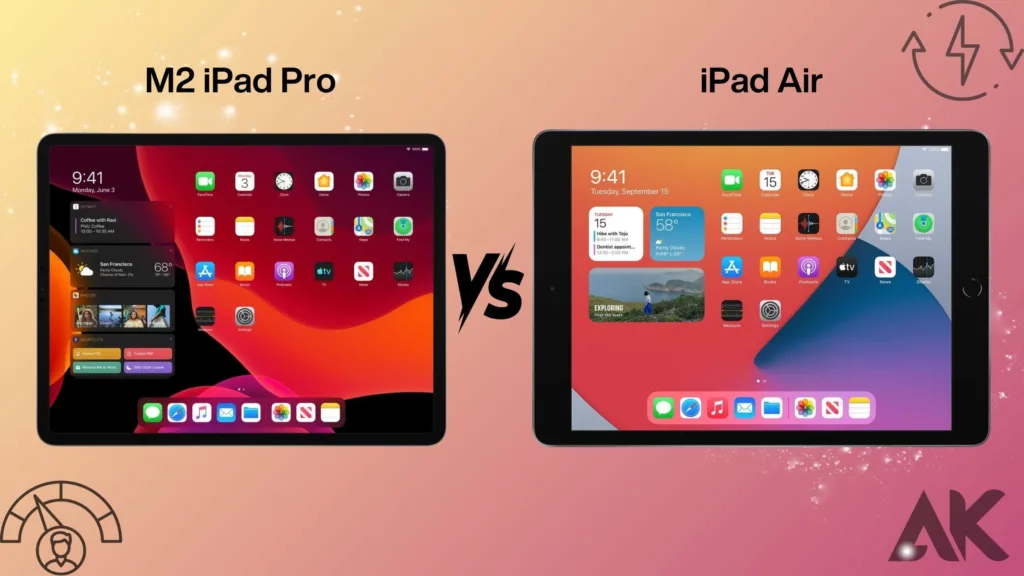
The difference between the M2 iPad Pro and the iPad Air becomes more noticeable, however, when dealing with jobs that need intense processing capacity, such as graphic design, video editing, and 3D modeling. Faster rendering, more fluid animations, and more efficient machine learning are all results of the M2’s enhanced neural engine and more GPU cores. Because of this, the M2 iPad Pro is the superior option for artists and professionals who want more processing power. However, the iPad Air has more than adequate power for general usage, web surfing, and less demanding creative projects, making it a more budget-friendly choice for people who don’t need the very best performance.
M2 iPad Pro vs iPad Air Display and Visuals
Both the M2 iPad Pro and the iPad Air demonstrate Apple’s mastery of screen technology, making the display yet another point of contention in this comparison. The Liquid Retina XDR display of the M2 iPad Pro provides superb color accuracy, contrast, and brightness. Professionals who rely on their eyes for precise work will find this mini-LED technology indispensable, thanks to its deeper blacks and more vivid colors. Video playback and gaming are both made more fluid and realistic by the 120Hz refresh rate of the ProMotion technology, which further improves the viewing experience.
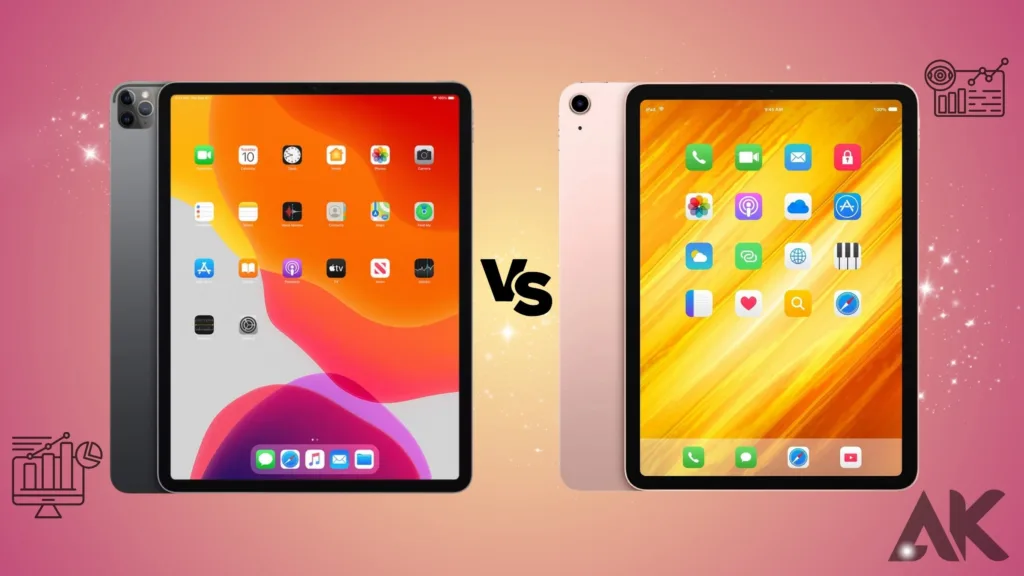
While the XDR screen of the iPad Pro is much more sophisticated, the iPad Air’s Liquid Retina display still offers superior quality compared to many rivals. All sorts of entertainment will look fantastic on it because of its high brightness, wide color gamut, and True Tone technology. Despite missing mini-LED technology and ProMotion, the display of the iPad Air is more than enough for casual usage, watching videos, and doing non-professional creative tasks.
The user’s display and visual demands determine the M2 iPad Pro versus iPad Air choice. The M2 iPad Pro is best for professionals and creatives who need precise and smooth images. For daily users who seek a high-quality display, the iPad Air balances performance and pricing.
M2 iPad Pro vs iPad Air Camera and Multimedia
The M2 iPad Pro and the iPad Air provide users with alternative camera and multimedia experiences, according to their specific demands. In addition to a LiDAR scanner for use in AR apps and a wide-angle and ultra-wide rear camera, the M2 iPad Pro has a more sophisticated camera system. For professionals and creatives who rely on these capabilities for their work, this configuration is ideal since it provides various alternatives for photography and filming and improves augmented reality experiences.
The iPad Air’s high-quality photographs and videos are perfect for casual photography, video chats, and general usage, even if it only has one wide camera. Like the M2 iPad Pro, it has Center Stage technology built into its front-facing camera, which automatically maintains a user’s precise framing during video chats. So, you can expect top-notch multimedia playback from either device, with the Pro version offering a little more flexibility and better overall quality.
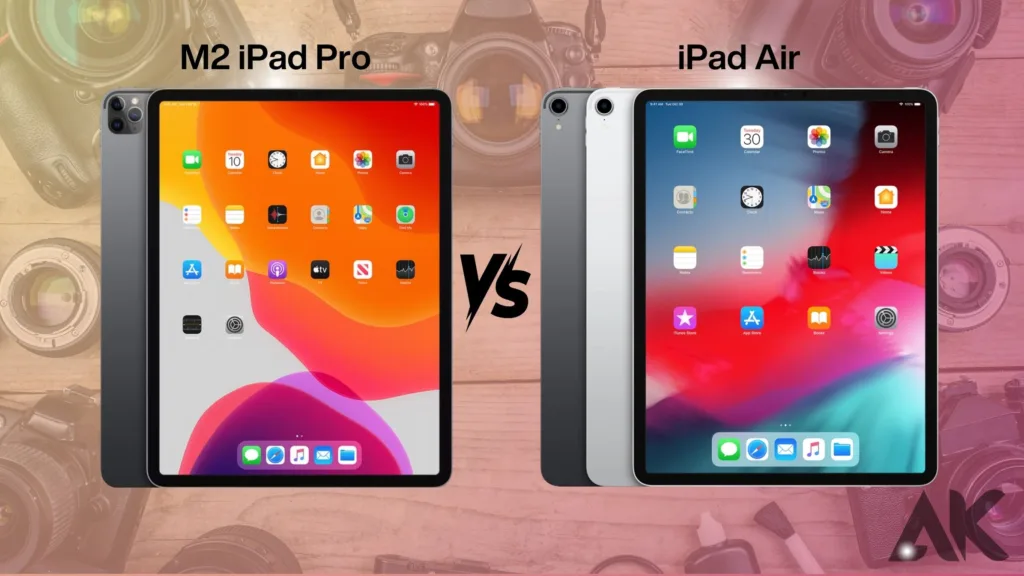
Both devices also shine in terms of audio quality; with their dual speaker setups, you can enjoy anything from movies and games to music and podcasts in complete immersion. When compared to the two-speaker system of the iPad Air, the four-speaker audio on the M2 iPad Pro provides a more powerful and immersive listening experience.
The user’s demands will determine the priority of camera and multimedia capabilities when deciding between the M2 iPad Pro and iPad Air. If you’re a professional or content creator who needs a top-notch camera system and audio, the M2 iPad Pro is your best bet. The iPad Air provides enough specs and quality for most people’s multimedia demands.
M2 iPad Pro vs iPad Air Battery Life and Charging
If you’re looking for a gadget with a lengthy battery life, go no further than the M2 iPad Pro or the iPad Air. Despite its robust hardware, Apple managed to squeeze all-day battery life into the M2 iPad Pro via software improvements and the efficiency of the M2 processor. This guarantees that users won’t have to worry about finding a charger halfway through the day, whether they’re working or playing.
Also, the battery life of the iPad Air is impressive, providing up to ten hours of movie playing or web surfing. Its stated battery life is the same as that of the M2 iPad Pro, although less demanding hardware can result in longer actual use, particularly for less demanding workloads. For those who value battery life above all else but may not want the additional power offered by the M2 processor, the iPad Air is a fantastic option.
Both of these things have rapid charging capabilities, so you can power up your tablet in no time and get back to your day. It should be noted that the M2 iPad Pro may need to be charged more often when used heavily, particularly for operations that make use of its superior display and performance capabilities.
M2 iPad Pro vs iPad Air Connectivity and Expansion
The ability to connect a wide variety of peripherals and accessories is an important consideration for consumers when comparing the M2 iPad Pro with the iPad Air, especially when it comes to expansion choices. The USB-C connector on the M2 iPad Pro is state-of-the-art, supporting Thunderbolt / USB 4. This allows for lightning-fast data transfers, compatibility with several screens, external devices, and a plethora of accessories. The M2 iPad Pro becomes a multi-device capable workstation with this level of connection, perfect for professionals who need high-performance connectivity for their projects. It can handle complicated tasks and settings with ease.
Although it has a USB-C connector, the iPad Air does not support Thunderbolt. While it is compatible with regular USB-C connections, it is not up to the level of the M2 iPad Pro in terms of fast data transmission or compatibility with multiple displays. The iPad Air strikes a good mix of mobility and usefulness with its many connection choices, which are enough for the majority of users. This device is still capable of connecting to a range of peripherals, such as external storage, keyboards, and mouse, so it’s perfect for daily usage and lighter creative work.
The inclusion of Wi-Fi 6 in both devices guarantees dependable and speedy internet connections. You can’t have cloud-based workflows, high-quality video streaming, or video conferencing without this. Cellular data plans are available for both models, so customers can keep in touch even when Wi-Fi is down. When deciding between the M2 iPad Pro and the iPad Air, users should consider how much data they need to transmit quickly, how many screens they want, and whether or not they need to connect to sophisticated peripherals.
M2 iPad Pro vs iPad Air Software and Ecosystem Integration
A key component of the M2 iPad Pro versus iPad Air comparison is the software experience. The two tablets are powered by iPadOS, which provides access to a vast library of software optimized for their powerful hardware. With capabilities like multitasking, drag-and-drop, and an improved file system, iPadOS offers a flexible platform that connects mobile and desktop computing. By integrating with other Apple services like iCloud, Continuity, and Handoff, the user experience is much improved, and it becomes even easier to share and collaborate on files across all of your Apple devices.
Since it has more powerful hardware, the M2 iPad Pro should make using resource-intensive applications and multitasking easier. With its enhanced efficiency, it will be able to effortlessly manage future iPadOS upgrades and feature additions to apps. The M2 iPad Pro is the best iPadOS tablet for power users that need a lot of storage space, plenty of processing power, and a lot of creative freedom.
Conversely, the vast majority of iPadOS customers will have more than enough satisfaction with the iPad Air. It strikes a good mix of portability and performance with its M1 chip, which makes it suitable for running most programs. Without the hefty price tag of the Pro model, the iPad Air provides users with all the software features they need for everyday work, online surfing, and media consumption.
The software and system integration of the M2 iPad Pro versus the iPad Air comes down to personal preference and the user’s intended usage of the device inside Apple’s ecosystem.
M2 iPad Pro vs iPad Air Price and Value Proposition
Price and value proposition are the deciding factors in any comparison between the M2 iPad Pro and iPad Air. Due to its high-end design and powerful hardware, the M2 iPad Pro is not cheap. A professional, artist, or power user who demands the most from their device in terms of speed, screen, and connection may find the M2 iPad Pro to be a worthwhile purchase. Its outstanding display technology, ability to handle intense activities, and broad networking choices make it a formidable tool for many professional uses.
If you’re after a device that strikes a good mix between affordability and performance, however, the iPad Air might be a good pick. It may be missing some of the premium features found in the M2 iPad Pro, but the M1 processor, excellent screen, and sturdy construction make up for it. At a more reasonable price, the iPad Air offers an attractive blend of features and performance, making it ideal for casual creatives, students, and typical users.
Whether one chooses the M2 iPad Pro or the iPad Air comes down to personal preference, spending limit, and device use. The Pro’s premium features make it a great purchase for anyone who can make good use of them. The iPad Air, on the other hand, stands out as a great option for budget-conscious consumers who are looking for a powerful and flexible tablet.
Conclusion
The advantages and disadvantages of the 2024 iPad Air and M2 iPad Pro are the main points of this comparison. Thanks to its cutting-edge CPU, the M2 iPad Pro provides outstanding performance, making it perfect for professionals and power users. If you’re looking for a low-priced tablet with respectable specs, however, the iPad Air is a solid pick. To assist consumers in making an educated choice, the comparison takes into account design, performance, display, camera, battery life, and connection, among other elements.
FAQs
Which one is better iPad Pro or iPad Air?
There isn’t a huge speed boost from the M2 CPU, but the iPad Pro should keep running smoothly for a longer period than the iPad Air. The seamless ProMotion screen and Face ID are other features you will love. The Hover function on the iPad Pro may be the deciding factor for Apple Pencil users.
Is M2 iPad overkill?
For those who don’t need the additional processing power, the M2 iPad Pro can be too powerful for their battery life. Even if the M1 chip was formidable, the M2 chip takes it to a whole new level.

